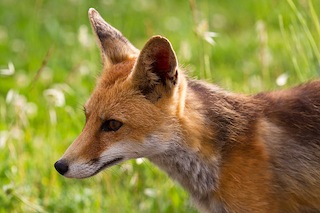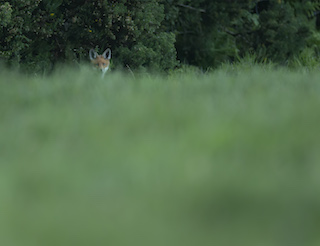 The Red Fox is largely nocturnal creature, but can sometimes be spotted in the daytime.
The Red Fox is largely nocturnal creature, but can sometimes be spotted in the daytime.
Photo: © Natural England/Allan Drewitt
Scientific name: Vulpes vulpes
Other common names: Fox (in areas where it is the only native Vulpes species, such as the UK), Silver Fox or Cross Fox (references to different colour variations), Reynard (in folklore and literature).
Cornish name: lowarn
Conservation status: IUCN, Least Concern
What to look for:
- Colouring: White or grey on its belly, chest and the end of its muzzle; red to reddish-brown above with darker legs and ears.
- Size: Similar to a small dog, up to 0.75 m in length plus the familiar long bushy tail (its brush). Dog foxes are a little larger than vixens.
- Where: Almost everywhere across its range, from city centres to the countryside to deserts.
- Vocalisations: Over 40 different vocalisations, including a bark and, at the breeding time of year, the unnerving scream that can sound like a distressed child.
- Similar species: None in the UK. Domestic dogs are probably the most similar but unlikely to be confused with foxes.
 The Red Fox is one of our most familiar mammal species. Its wide range is the largest of any other carnivore, including Europe, Asia and North America, and stretches as far north as the Arctic Circle. As a successful and adaptable predator, and with no predators of its own in the UK, it is considered to be vermin here, and a pest species in some areas, especially where it takes gamebirds, ground-nesting wild birds or farm livestock, or in urban areas where it has learned to scavenge from its human neighbours. Its numbers are therefore often controlled locally where there is conflict.
The Red Fox is one of our most familiar mammal species. Its wide range is the largest of any other carnivore, including Europe, Asia and North America, and stretches as far north as the Arctic Circle. As a successful and adaptable predator, and with no predators of its own in the UK, it is considered to be vermin here, and a pest species in some areas, especially where it takes gamebirds, ground-nesting wild birds or farm livestock, or in urban areas where it has learned to scavenge from its human neighbours. Its numbers are therefore often controlled locally where there is conflict.
Despite this, it is hard to deny that, in full health, this is one of our most beautiful mammals. The splash of red in the distance, especially on a cold or snowy day when the contrast with its thick, bright winter fur is particularly striking, is a thrill to spot as the fox trots purposefully along on a mission of its own.
Red Foxes are mostly active by night or at dusk, but daytime sightings are not uncommon in quieter, less disturbed areas. The cubs are born in the Spring, usually up to five or six per litter, although this number can be higher if food is plentiful and competition low. The average lifespan in the wild is around two years, with causes of mortality varying from disease to road traffic accidents, as well as control measures.
 Did you know…?
Did you know…?
…Where the range of Red and Arctic Foxes overlaps further north, the larger Red Fox generally always outcompetes its smaller cousin. A warming climate, with Red Foxes becoming able to extend their range further north due to better food availability, is therefore not good news for Arctic Foxes, as it increases the potential for competition between the two species.
…The Red Fox uses its brush for balance, tucked around its body as a source of warmth in winter, and to communicate with other foxes.
More information and references:
Cornwall Mammal Group, 2013. The Mammals of Cornwall and the Isles of Scilly (edited by David Groves). Environmental Records Centre for Cornwall and the Isles of Scilly (ERCCIS), Cornwall.
Published: April 2014
Author: Amanda Scott
Photos: Fox cub in hedgerow, © Richard Birchett; adult fox © Natural England/Allan Drewitt
